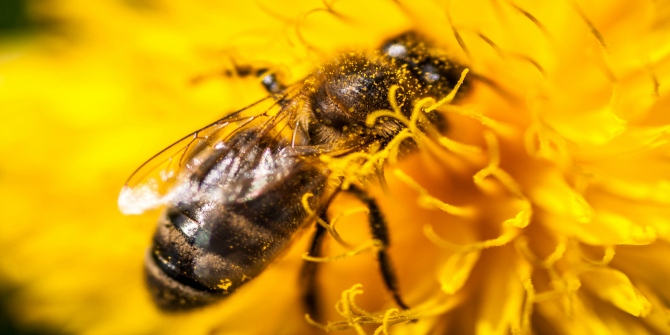With bee populations increasingly at risk, The Business of Bees: An Integrated Approach to Bee Decline and Corporate Responsibility, edited by Jill Atkins and Barry Atkins, provides an integrated account of how bee decline, consumers, companies, investors and stock markets are interconnected. The Secretary of LSESU Beekeeping Society, Sroyon Mukherjee, praises the book for providing concrete recommendations that include commercial activities as a necessary component of attempts to tackle threats to the global bee population.
The Business of Bees: An Integrated Approach to Bee Decline and Corporate Responsibility. Jill Atkins and Barry Atkins (eds). Greenleaf Publishing. 2016.
 Last winter LSE Bees lost one of its five precious honeybee colonies. Unfortunately, this was not an isolated incident, but a reflection of a wider trend. 28 per cent of American colonies were wiped out over the winter, and nearly one in ten wild bee species in Europe are threatened with extinction. In recent years, the threat to bee populations has been highlighted in a Time magazine cover story, by the UN and even by street artists in Shoreditch. To this chorus of concern, The Business of Bees: An Integrated Approach to Bee Decline and Corporate Responsibility adds an interesting new perspective. Drawing on the expertise of investment professionals, accountants and academics from diverse fields including science, finance and the humanities, the book explores the relationship between bee decline and companies, investors and stock markets.
Last winter LSE Bees lost one of its five precious honeybee colonies. Unfortunately, this was not an isolated incident, but a reflection of a wider trend. 28 per cent of American colonies were wiped out over the winter, and nearly one in ten wild bee species in Europe are threatened with extinction. In recent years, the threat to bee populations has been highlighted in a Time magazine cover story, by the UN and even by street artists in Shoreditch. To this chorus of concern, The Business of Bees: An Integrated Approach to Bee Decline and Corporate Responsibility adds an interesting new perspective. Drawing on the expertise of investment professionals, accountants and academics from diverse fields including science, finance and the humanities, the book explores the relationship between bee decline and companies, investors and stock markets.
The sixteen chapters in the book are divided into three parts. Part I provides some historical, cultural, philosophical and scientific context on bees and bee decline. Part II explores the relationship between bee decline and the stock market, and Part III analyses ‘bee accounting’, i.e. the ways in which companies account for ‘their dependencies and impacts on pollinators and their services’ (188).
In the first and final chapters of the book, the editors outline a theoretical framework for an integrated analysis of bee decline and seek to identify salient themes underlying the various contributions. Chapter One in particular introduces a number of intriguing theoretical and philosophical concepts: the intrinsic value of bees; general systems theory which emphasises a holistic (as opposed to an atomistic or reductionist) approach; the butterfly effect; and the possibility of a ‘bee centric’, rather than anthropocentric, viewpoint. However, most of the subsequent chapters in Parts II and III of the book have a narrower, technical focus on companies, investors and accounting. This means that readers with a more general interest in bee welfare would probably be more interested in the first three chapters.
Image Credit: ‘Bee’ by Kamil Porembiński licensed under CC BY SA 2.0
In Chapter Six, Rick Stathers provides a systematic and informative overview of pollinator decline and its extent, causes and economic impact. He highlights five sectors (agrochemicals, food retailers, food producers, luxury goods and beverages) that have exposure to pollinator decline, and makes an original contribution in the form of a content analysis of publicly available information for 25 companies in those sectors ‘in order to develop a snapshot of the level of discussion on this topic’ (124). Stathers’s main finding is that pollinator decline is currently not affecting operating costs for most companies, but ‘all companies recognize it as an issue, acknowledging that pollinators provide an economic service which is only likely to be recognized should the service cease or be seriously reduced’ (126).
While Stathers focuses on the impact of pollinator decline on companies and the stock market, the causality runs in both directions – the actions of companies can also have an impact on bee populations, such as through increased pesticide use or habitat loss. But with the right incentives, the impact can also be positive. Thus, in Chapter Nine, Raj Thamotheram and Olivia Stewart map out an investment system based on fiduciary capitalism which emphasises long-term thinking, loyalty and a duty of care. The authors argue that such a system would be better equipped for dealing with systemic risks such as bee decline, but ‘[t]he main problem with fiduciary capitalism is that it is not here yet’ (171). Their chapter therefore concludes with a useful section on what investors and other stakeholders need to do to bring about meaningful change.
The three-part division of the book works well on the whole. However, a couple of chapters, while being useful contributions in their own right, seem not to fit quite as well into the overall thematic structure. In particular, I am skeptical about the inclusion of Chapter Four – concerning the bumblebee trade in Japan and the Japanese legislative response – in Part I, which is purportedly about the historical, cultural, philosophical and scientific context of bee decline. Chapter Fifteen, which discusses ‘bee accounting’ in Germany, adopts a conspicuously different approach and methodology from the preceding chapters, which focus on the UK, USA, South Africa and Sweden.
The order of chapters also means that despite the multiple references to ‘bee decline’, including in the subtitle of the book itself, it is not until the aforementioned Chapter Six (by Stathers) that we find hard statistics about global bee populations. The numbers may come as a surprise to some readers: despite some regional declines, between 1960 and 2010 the number of managed beehives globally has actually increased by nearly 45 per cent (112). However, that does not mean that the problem is illusory. In the same period, agricultural production requiring animal pollination has increased four-fold, and wild bee populations have severely declined. Given that different readers may come to the book looking for different things, and considering the diversity of themes covered – Chapter Two alone has references to deep ecology, communism and Shakespeare – I also feel the inclusion of an index would have been useful.
The Business of Bees is potentially of more value to companies that have exposure to, or whose activities have an impact on, pollinator decline, and to responsible investors who are concerned about environmental, social and governance implications of investment decisions. Regulators and policymakers may also be able to draw lessons from the experience of their counterparts in other countries such as Japan (Chapter Four) and the USA (Chapter Twelve).
There is a long shared history between honeybees and economic activity. The worker bee is a symbol of industry, and The Fable of the Bees – an early eighteenth-century work by the Dutch philosopher Bernard Mandeville – influenced Adam Smith, John Maynard Keynes and Friedrich Hayek, among others. Likewise, the decline in bee populations is not a problem solely within the province of biologists and beekeepers. It is inseparably linked to commercial activity, and any comprehensive attempt to address it must involve companies, shareholders, fund managers and consumers. Translating scientific findings, corporate governance and accounting theory into concrete recommendations, The Business of Bees provides a unique and necessary roadmap for such involvement.
Note: This review gives the views of the author, and not the position of the LSE Review of Books blog, or of the London School of Economics.









A very nice review of a book on a crucial topic.